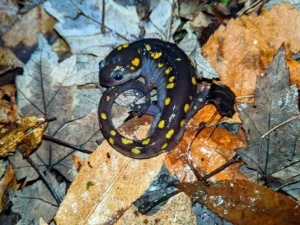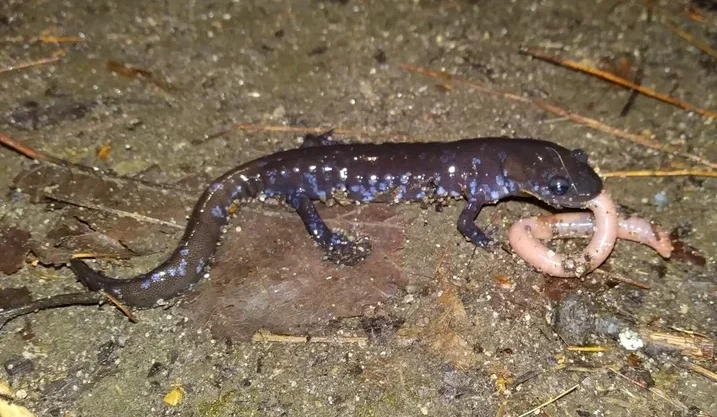Salamanders are interesting creatures often kept as pets. But have you ever wondered, do these secretive little animals actually need UVB light?
Some salamanders do benefit from UVB, but it really depends on the species and how they live. Not all salamanders are the same. Some spend most of their lives underground or in dark ponds, while others move around under leaves or near the surface. Their need for UVB changes with their habits.
Why UVB Matters for Some Salamanders
UVB is a type of sunlight. It helps animals make vitamin D3, which is very important for bones, muscles, and even their immune systems. Without enough vitamin D3, salamanders can get weak bones, bent legs, or have trouble fighting off sickness.
Some salamanders, like those that spend time out in the open during the day, naturally get UVB from sunlight.
Tiger salamanders, for example, sometimes walk near ponds or under low branches in the daytime. They get just enough light to stay healthy.

Other salamanders, like axolotls, live entirely underwater in the wild. They barely see any sunlight. These salamanders get most of their vitamin D3 from the food they eat.
So, whether a salamander needs UVB really depends on where it comes from and how it lives.
How Salamanders Use Vitamin D3
You might think a salamander just crawls around and that’s it. But inside, their bodies are working hard.
Vitamin D3 helps them absorb calcium. Calcium is what makes their bones strong and lets them move without injury.
Imagine a salamander climbing over wet leaves or burrowing into soft mud. Every twist and turn puts stress on their tiny bones.

Without enough calcium, their legs could bend in strange ways or even break.
UVB helps them make their own vitamin D3, which then helps them use calcium from their diet. But it’s not just about bones.
Vitamin D3 also helps their immune system fight infections. A salamander that gets a little UVB, even a small amount, might be better at resisting disease.
Do All Salamanders Need UVB?
Not really. Salamanders fall into two broad groups based on where they live:
-
Aquatic salamanders: These live mostly in water, like axolotls and mudpuppies. They spend most of their time under rocks or in deep water, where sunlight barely reaches. In captivity, they usually don’t need UVB lamps if their food has enough vitamin D3 and calcium.
-
Terrestrial salamanders: These live on land or split their time between land and water, like tiger salamanders, spotted salamanders, and fire salamanders. They can benefit from some UVB, especially if they come out during the day. In the wild, they often get small bursts of sunlight that help them make vitamin D3.
Basically, if a salamander naturally lives in dark, hidden places, UVB isn’t as important.
If it comes out into sunlight or spends time on the surface, UVB can help keep it strong and healthy.
How Much UVB is Enough?
If your salamander could talk, it might say, “Just a little, please!” They don’t need hours of bright sunlight like a lizard. Even low levels of UVB, like sunlight filtered through tree leaves, can be enough for terrestrial salamanders.
For example, imagine a spotted salamander sitting under a mossy log. Light filters through cracks in the trees above.

It’s not full sun, but it’s enough for the salamander’s skin to make some vitamin D3. That’s often all they need.
In captivity, a low-output UVB bulb or a few hours of natural sunlight a week can be enough.
You don’t need a super-strong lamp shining all day. Too much UVB can stress them, and salamanders like to hide from bright light anyway.
A Few Examples of Salamanders and Their UVB Needs
Many keepers notice differences between salamanders with UVB exposure and those without:
-
Terrestrial salamanders with UVB: They are often more active, move around more, and have strong bones. They explore their enclosure and look curious. Diet alone sometimes isn’t enough for all their vitamin D3.
-
Terrestrial salamanders without UVB: Young salamanders may grow slower or have weaker legs. They might still survive on diet alone, but could be a bit more prone to illness or injury.
-
Aquatic salamanders: Axolotls usually do fine without UVB. With vitamin-rich food, they grow strong without seeing sunlight.
So, when you think about UVB, it really comes down to the species and how they live.
How Salamanders Avoid Too Much Light
Even salamanders that benefit from UVB are careful. Many hide under leaves, moss, or logs during the brightest parts of the day.
They are small, soft-skinned animals, and too much sunlight can dry them out.
In captivity, if you provide UVB, you also need hiding spots. Salamanders should always be able to move out of direct light. That way, they get vitamin D3 without getting stressed or dried out.
Natural Habits and UVB in the Wild
Looking at wild salamanders helps understand their UVB needs:
-
Spotted salamanders: Mostly come out at night or on damp days. They get very little sunlight, maybe a few rays in the morning.
-
Tiger salamanders: Sometimes out during the day, especially young ones. Crawl in open fields briefly, getting a bit of UVB.
-
Marbled salamanders: Mostly underground or under leaf litter. Hardly see sunlight. They rely on food for vitamin D3.
You can see their light exposure varies a lot. Salamanders don’t bask like lizards. They use small amounts of light, or none at all, depending on the species.
How to Know if Your Salamander Needs UVB
If you keep a salamander, deciding on UVB can feel tricky. Here’s a simple way:
-
Know your species: Is it mostly aquatic or terrestrial? Does it come out in daylight in the wild?
-
Check the diet: Make sure food has calcium and vitamin D3. Many pet foods are fortified.
-
Provide low-level UVB if needed: For terrestrial species, a low-output bulb for a few hours a day works. They choose when to sit under it.
-
Offer hiding spots: Always give places to hide so the salamander can control how much light it gets.
UVB is a tool, not a rule. Some salamanders get enough from food and behavior alone. Others, especially those exploring leaf litter or ponds, can benefit from small, controlled amounts.
What Happens Without UVB
If a terrestrial salamander never gets UVB and its diet isn’t fortified, problems can appear slowly:
-
Bones may become soft or weak, making movement hard.
-
Legs may bend or break more easily.
-
Young salamanders may grow slower.
-
Immune system can weaken, making them more likely to get sick.
For aquatic species like axolotls, this is rarely a problem because their diet usually provides what they need.
UVB isn’t magic, but it can be a helpful part of care for certain salamanders.
Common Misconceptions
You might hear that “all salamanders need UVB” or “UVB is dangerous.”
Both are too simple:
-
Not all salamanders need UVB: Aquatic and hidden species often thrive without it.
-
UVB isn’t dangerous if used properly: Low levels with hiding spots are safe. High-output UVB or leaving it on all day can stress them.
-
Diet can replace UVB for some species: Fortified food can give vitamin D3, especially for aquatic salamanders.
Salamanders are flexible. They survive in many environments, and their care should match their natural habits.
Conclusion
So, do salamanders need UVB? It depends. Some terrestrial species benefit from small amounts to make vitamin D3 and use calcium properly. Aquatic species and those staying in dark places usually do fine without it.
Think like a salamander: where do they live in the wild? How much light do they get? What do they eat? Matching care to their natural habits helps them stay strong, healthy, and active.
UVB is a tool, not a rule. Some get enough from food and behavior, others benefit from small, controlled light.
Either way, hiding spots, a varied diet, and a natural setup are just as important as any lamp.
Salamanders are quiet, secretive, and interesting little animals. Understanding their needs, including UVB, helps them thrive and gives you a better view into their slow, careful world.

